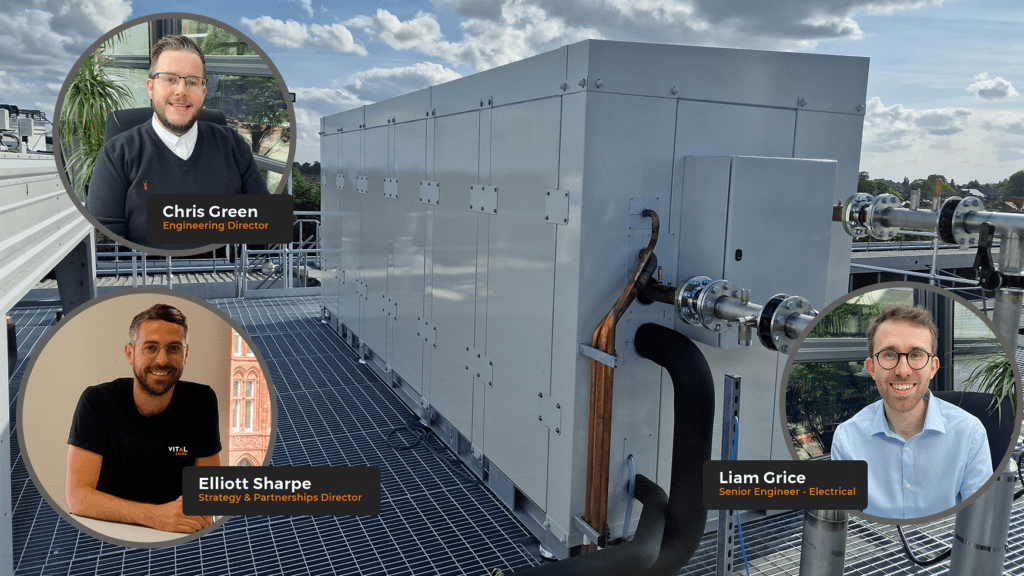
When choosing the right one to suit your organisation or site, though, the task can seem daunting as so many variables can affect performance and efficiency.
Vital Energi’s Elliott Sharpe (strategy and partnerships director), Chris Green (engineering director), and Liam Grice (senior engineer) have shared five key factors you should consider before embarking on your heat pump journey.
Do you have metered data?
Before you leap into the world of heat pumps, it’s crucial to get acquainted with one essential element of your building’s energy puzzle: metered data. Why is this data so important? Well, the compass guides you toward the most efficient solution and best application of your heat pump.
Imagine buying clothes without knowing your exact size – it’s a gamble. Similarly, choosing a heat pump without metered data or some energy data can be a gamble. Accurate energy usage data helps you determine the right-sized heat pump for your building, preventing an oversized or undersized system that can lead to inefficiency and high energy bills.

Heat pumps are renowned for their energy efficiency, but to truly reap the rewards, you need to know how much energy your building consumes. Metered data helps identify energy waste and inefficiencies, allowing you to address them and maximize the cost savings potential of your heat pump. So, before you embark on your heat pump journey, start with the data – it’s the key to unlocking efficiency, savings, and environmental benefits.
Choose your refrigerant wisely
One of the largest factors determining a heat pump’s efficiency and performance is its working fluid. There is no ‘one size fits all’ refrigerant, so carefully considering your requirements is essential to selecting the optimum fluid.
Think about regulatory requirements, too. Impending regulation changes may mean the heat pump can be installed now. However, future maintenance challenges may arise, so working fluid selection is critical to ensure the heat pump can be serviced reliably and cost-effectively for the product’s life.
Natural working fluids often have a lower environmental impact than synthetic counterparts. They have extremely low global warming potential and do not contain forever chemicals, making them a great option to futureproof your heat pump.
Check your electrical capacity
Before investing in a heat pump, there’s a crucial step that often gets overlooked but can make or break your decision: checking your building’s/site’s electrical capacity. Understanding your power supply is not just a technicality; it’s a fundamental prerequisite for a successful installation; after all, heat pumps require an electrical power supply to operate.
Investing in and installing a heat pump without assessing your electrical capacity can be risky. By checking your capacity upfront, you eliminate any costly surprises. Sometimes, you might discover that your building’s electrical capacity is insufficient for a heat pump. This isn’t necessarily a roadblock; it’s a chance to plan for an upgrade. Upgrading your electrical system can expand your options and allow for the expansion of your commercial heat pump solution.
In conclusion, understanding your building’s electrical capacity is a foundational step in the heat pump journey. It ensures that you know your building/development is ready to cater for your new heat pump solution and identify any electrical enabling works early before you invest in that initial heat pump. Don’t let electrical surprises derail your decarbonisation journey—start with a thorough capacity check.
What temperature do you need?
A heat pump typically operates at its best when delivering lower temperatures. It is essential to consider how this heat will be delivered throughout your building. Keeping existing pipework and heat emitters may help to reduce capital spending. However, this could well be at the detriment to operational costs.
Do you have any building upgrades planned? Building fabric improvements, new windows, or perhaps an extension? Consider these when reviewing the temperature and distribution of heat across your premises.
A heat pump is a big investment. Considering these factors in advance will give you the best possible opportunity for a long, successful lifespan.
Consider your source of energy
Air source heat pumps are often the most straightforward solution for organisations and can offer fantastic efficiencies and carbon reductions compared to conventional heating systems. However, is there an opportunity to use an energy source with a warmer temperature than air?
Consider whether you can use your surroundings to your advantage. Perhaps this could be a local water source, such as a river or lake. What about the ground source? A ground array, borehole or aquifer can provide favourable source conditions. Is there an existing waste heat stream you could use? An industrial process or refrigeration system may be rejecting heat to the ambient air already; recovering this might be the perfect source. Or maybe a combination of any of these?

